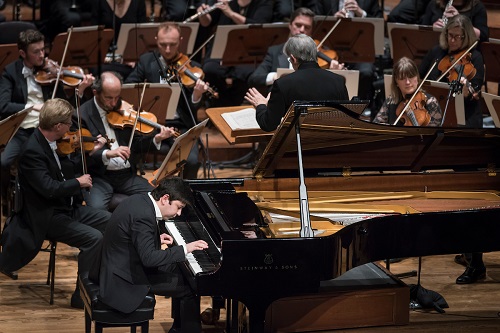 United States Wuorinen, Prokofiev, Copland: Behzod Abduraimov (piano), San Francisco Symphony / Michael Tilson Thomas (conductor), Davies Symphony Hall, San Francisco. 15.3.2018. (HS)
United States Wuorinen, Prokofiev, Copland: Behzod Abduraimov (piano), San Francisco Symphony / Michael Tilson Thomas (conductor), Davies Symphony Hall, San Francisco. 15.3.2018. (HS)

(c) Stefan Cohen
Charles Wuorinen — Sudden Changes (world premiere)
Prokofiev — Piano Concerto No.3 in C major
Copland — Symphony No.3
When it was announced that Michael Tilson Thomas and the San Francisco Symphony would be recording Copland’s Third Symphony at its concerts this week, one’s first thought might have been ‘what took so long?’ Under its own SFS Media label the orchestra long ago recorded much of Copland’s orchestral music on ‘Copland: The Populist’, and ‘Copland: The Modernist’, adding the Short Symphony and the Organ Symphony in tandem with other American composers on later discs.
Perhaps it was the shadow of Leonard Bernstein’s recording of the Third, a seminal version of arguably the greatest symphony by an American composer. Certainly the symphony is the most ‘American-sounding’, since Copland created the wide-open harmonies and gestures almost every composer since has employed to portray the United States. It’s been 15 years since the orchestra and this conductor last played this work, and brought it on a European tour.
Heard Wednesday evening at Davies Symphony Hall, the piece made a huge impact in a muscular, majestic reading. The thrilling concert also included a world premiere by Charles Wuorinen, and an eye-popping performance of Prokofiev’s Piano Concerto No.3 with the 27-year-old Uzbekhian pianist Behzod Abduraimov.
Copland has always been a great fit for this conductor and orchestra. The glassy textures of the harmonies, the layering of the musical lines, the shifts in rhythm all come through with naturalness and vigor. The Third Symphony has a brashness and tendency to get loud that can strike a listener as either overbearing or thrilling. Count this performance in the latter column.
The quiet gambit of the opening measures alludes to melodic lines in Fanfare for the Common Man, which provided many of the symphony’s musical ideas. The orchestra barely settled into these subtle threads before it quickly built up steam, in one brief climax after another. There was nothing tentative, just a sense of exploration as the material developed.
Things got more intense in the second-movement Allegro molto, a scherzo with a brassy rising theme that recurs like a boisterous intruder, amping up the anticipation of that fanfare. The short, almost pastoral Andantino quasi allegro creates a bridge to the majestic finale, briefly fooling listeners into settling into a long, bucolic bath, before it starts weaving in quiet strands of the Fanfare. When the familiar theme finally bursts into the open, it’s in a slightly different form than listeners are accustomed to hearing when the fanfare is played separately.
Tilson Thomas seemed to revel in these subtle discrepancies. He emphasized the changes as each broad, stentorian statement took a slightly different twist, turning what could have been repetitious climaxes into a fascinating kaleidoscope. The conclusion, with timpanist Edward Stephan doubling up with big gestures and the brass creating a rich sound, brought things home with panache.
Charles Wuorinen was a child when Copland’s symphony debuted in Boston under the baton of Serge Koussevitsky. Now almost 80, Wuorinen has enjoyed a rich career, including a stint in the 1980s running this orchestra’s new music program and a number of commissions since. He is a consummate craftsman, creating fine balances in big works, using a musical language that is often challenging for its dissonance and restlessness.
In a program note he calls Sudden Changes ‘lighthearted’, and indeed it includes some measures with jaunty syncopation, jazzy harmonies with added sixths and ninths, and a soft, smooth finish. But along the way, it careens from one idea to another so quickly that it feels like being in a house of mirrors—and what’s coming around the corner is sometimes pretty scary. The orchestra gave it a big-hearted reading, and it will be worth hearing again, now that the direction of its musical ideas is more familiar.
The Prokofiev concerto proved an apt showpiece. Sandwiched between Wuorinen’s spiky harmonies and Copland’s wide-open spaces, its pungency stood out, and provided plenty of chances for the soloist’s dazzling technique. Abduraimov delivered with cascades of pianistic flourishes, snappy rhythmic attention, and control over dynamics that brought out all of the composer’s colors. Tilson Thomas and the orchestra were with him every step of the way.
Harvey Steiman